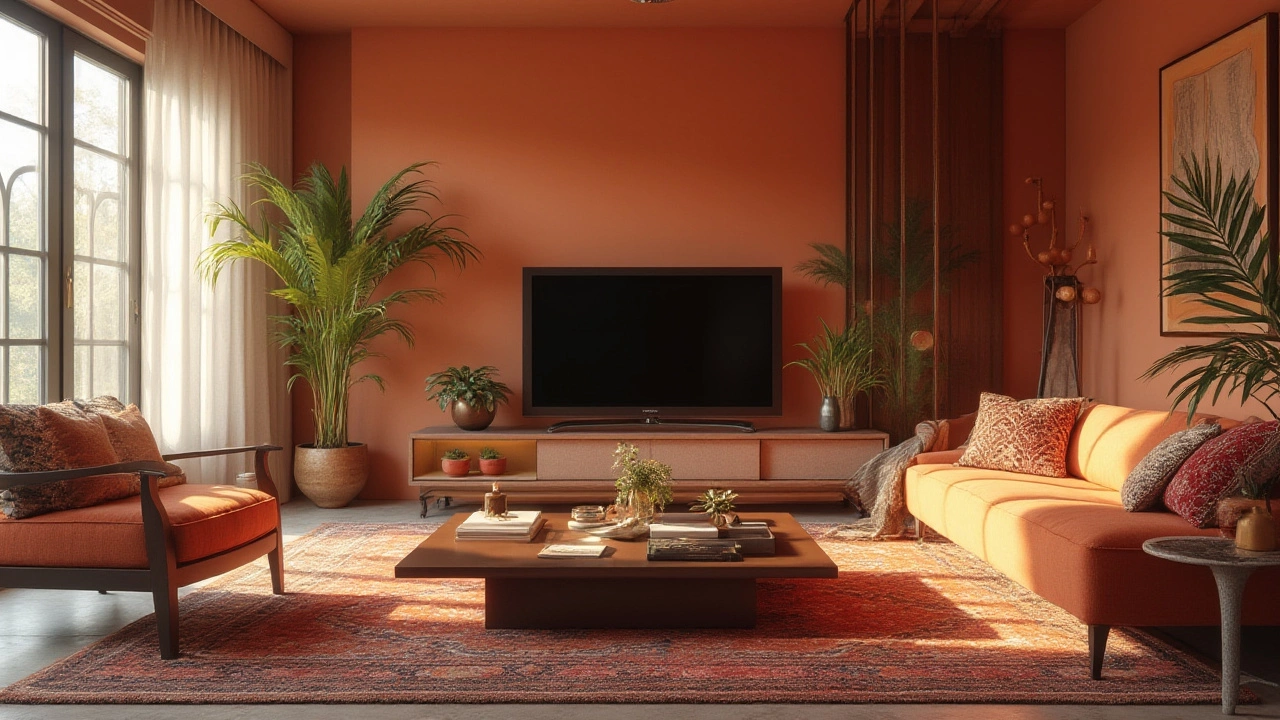Picture this: you’ve got the perfect spot for your morning coffee, and the latest must-watch show is loaded up on the big screen. But as you look around, something feels just a little off. That coffee table, your TV stand, and the couch—they aren’t exactly in harmony, and you can’t help but wonder: does matching your coffee table to your TV stand make a bigger difference, or should your coffee table sync up with your couch instead? This question has stumped a lot of homeowners, renters, and even a few interior designers. Styles change, trends clash, and let’s be honest—no one wants their living room to end up looking like a mismatched furniture clearance bin. Let’s dig into what really matters when you’re picking out these three furniture MVPs.
The Design Debate: Matching or Coordinating?
First off, matching doesn’t have to mean boring, and mixing doesn’t have to look chaotic. According to a 2024 survey by Houzz, about 58% of homeowners prefer a balanced approach where pieces coordinate but don’t necessarily match in identical looks. Why? Perfectly matching sets—say, a coffee table, TV stand, and side tables all in the same chipboard—can flip a living room from inviting to showroom-y in minutes. But that doesn’t mean you should toss rules out the window. There’s a rhythm to pairing furniture, and it often comes down to one question: do you want your living room to feel put-together or more relaxed and lived-in?
Interior designers often start by looking at the room’s layout and its anchor—usually the couch. This makes sense: the couch is typically the largest piece, dominating the visual vibe. But that doesn’t mean every furniture piece should be exactly the same colour or style. If you have a bold velvet sofa in emerald green, a matching coffee table risks feeling fussy. Instead, try echoing details: the coffee table could have brass legs that pick up the sofa’s nailhead trim, or a wooden TV stand might coordinate with side tables.
TV stands serve a unique role—they hold the eye because they support your big, glowing TV. If your living room is TV-centric, finding a coffee table that complements the TV stand can create a harmonious look. For example, mixing a walnut TV stand with a glass-top coffee table incorporating wooden details pulls the room together without being too matchy-matchy. Matching materials can look sharp, but matching style details—like mid-century slanted legs or industrial hardware—can work just as well.
Don’t forget function. Coffee tables get heavy action: feet propped up, laptops plonked down, endless drinks and game night snacks. Opt for something tough if you’re hard on furniture, but if you have a vintage TV stand, there’s nothing wrong with hunting for a secondhand coffee table in a similar wood finish. If your TV stand features hidden storage, consider a coffee table with lift-up sections. It pulls the whole setup together without looking cloned.
Now, about that couch. Let your fabric and cushion choices do most of the talking. Don’t stress if your coffee table doesn’t match exactly, especially if your couch is a neutral color like beige, grey, or navy. Patterned or bold-color couches can benefit from quieter, neutral-toned coffee tables and TV stands, giving the eyes a spot to rest. Want to shake things up? Mix metal and wood, or glass and stone—a look that’s been trending in the last couple years for its layered, high-end style.
Here’s an interesting stat: Ikea’s 2022 Living Room Report showed households mostly pair coffee tables and TV stands by material, not by color. Only 34% go for a perfect set. Most people want the freedom to swap out a trendy item down the line. Matching everything locks you into one look, which gets stale fast if you ever move or re-decorate.
Got an open-plan space? You might want more coordination. With fewer walls, the line of sight from couch to TV is longer, so mismatched furniture can look a little haphazard. In smaller living rooms, a single design element—wood finish, metal trim, similar shapes—is enough to tie things together. A table showing common combinations from recent design surveys can help you get a feel for what looks best:
| Combo Style | Most Popular Finish | Trend (2024-2025) | Perfect Match % |
|---|---|---|---|
| Coffee Table & TV Stand | Mixed Wood & Metal | Coordinated Accents | 34% |
| Coffee Table & Couch | Neutral & Natural | Contrast Pairing | 22% |
| TV Stand & Couch | Dark Wood & Fabric | Bold Color Sofa, Simple Stand | 18% |
In short? You don’t need to match everything, but some harmony—whether it’s finish, hardware, or leg shape—can make your space feel pulled together without being overdone.

Real-World Tips For Pulling Off The Look
You want more than just ideas—you want steps you can actually use when you’re shopping around. First, stop trying to force all your pieces to match exactly. That rarely works unless you’re buying an expensive set put together by a designer. Instead, think about how you want your living room to feel.
Bright and open spaces tend to look great with mixed textures—think a mid-century wooden TV stand, a leather tufted sofa, and a glass and metal coffee table. Smaller living rooms might need pieces that visually "lighten" the space, like a whitewashed wood table with a matching shelf under your TV. And if you’re renting, modular or IKEA furniture gives you way more flexibility for rearranging or updating as trends shift.
Here are a few concrete tips you can try next time you’re hunting for that perfect combo:
- Pick one piece as your anchor (usually the couch), then repeat an element in your other pieces. For example, a chunky armrest gets echoed in a thick coffee table top or a TV stand with a solid base.
- Don’t pair high-gloss TV stands with rustic wood coffee tables unless you want a very strong contrast. Try layering glossy surfaces with matte metals to soften the look.
- Use textiles (rugs, throws, cushions) as the “bridge” between different types of furniture. A bold patterned rug can tie together a dark sofa and light wood coffee table like magic.
- When in doubt, keep one clear line: match coffee table and TV stand by material, then let the couch go its own way in color or texture.
- Don't ignore shape and scale. Oversized couches with tiny coffee tables just look odd—try to keep things balanced.
- If antiques or vintage is your vibe, the contrast is the point. Pair a carved wooden coffee table with a sleek, modern metal TV stand, just keep something consistent (height, color undertone, or legs).
Professional designers have a neat trick: they always check the distance between furniture pieces. Coffee tables usually sit about 18 inches from the sofa for easy access. TV stands should be about a foot taller than the coffee table, give or take, to keep lines clean across the room. Get out your tape measure and see for yourself—those extra inches can make the whole room feel more deliberate and comfortable.
Smart storage is another hack. If you can, get a coffee table with a lower shelf, or an ottoman with hidden storage. That way, you avoid clutter and the remaining visible surfaces look more coordinated and curated.
Another overlooked detail is the legs on your furniture. Thin, tapered legs work for mid-century homes. Chunky, blocky legs suit more industrial or rustic rooms. Ongoing 2024 trend reports say swapping out cheap sofa legs for solid wood alternatives instantly makes even IKEA furniture look designer without matching everything else in the room.
Lighting also plays a role. A well-placed floor lamp or a statement overhead fixture can spotlight furniture elements you want to draw the eye to—making subtle differences less jarring.
Want to go bolder? Don’t be shy about mixing metals and finishes, as long as you keep one “family” element the same. Chrome, brass, black matte—they can all live together if they show up more than once. A glass coffee table and mirrored TV stand can coexist as long as your rug or pillows echo their lines or sheen.
And don’t get stuck on price. Thrift stores, vintage markets, and Facebook Marketplace are goldmines for unique pieces that can add character without being expensive. In fact, a 2023 Apartment Therapy survey found 47% of respondents were more satisfied with their living room style after adding at least one secondhand piece, rather than chasing perfection in a single set.

Living Room Examples and the Psychology Behind the Match
Let’s break down real-life setups that work, and why. Sarah, a single mom in Chicago, wanted her living room to be kid-friendly but stylish. She went with a light grey sectional, paired it with a walnut TV stand, and picked a concrete-topped coffee table with walnut legs. The result? Playful and modern, without any piece looking cookie-cutter. The secret: she tied the walnut wood across two pieces, and the grey fabric got echoed in throw pillows and a framed print above the TV.
Compare that to Jason and Priya in London. Their living room is tiny, barely fitting a two-seater sofa. They matched a petite white TV stand to their white, round coffee table, letting a navy velvet sofa pop as the only color statement in the room. Simple, but super effective—the eye isn’t overwhelmed by too many different finishes.
There’s actual psychology at work here. When your eye sees too many matching pieces, the brain says “store display.” When things are too random, it reads as messy. But when you repeat just one or two elements—legs, finish, or hardware—a sense of intention cools things off. Studies published in Psychology of Aesthetics, Creativity, and the Arts (2023) suggest humans feel more at ease in rooms where about 40% of elements align, and the other 60% provide visual variety. So, if your TV stand and coffee table have similar wood tones, your couch can be totally different in color or style and the room will still feel balanced.
Open shelving near your TV stand? Fill it with coffee table books or baskets in complementary hues. Got a statement rug? Pick a coffee table that partially blends in, so the pattern really sings. If your living room leans minimalist, two strong, matching elements are enough—the rest can stay simple. But for boho or eclectic spaces, go wild with colors and textures, just looping in one unimposing detail for consistency.
There’s a reason the living room is often called the heart of the home. It’s where you unwind after work, binge a new series, and kick your feet up with friends or family. Make it work for your style, not just someone else’s checklist. Want a rule of thumb? Try this: match your coffee table to your TV stand if your couch is a statement piece, and coordinate your coffee table with the couch if your TV stand is muted or blends into the background. It’s not about strict rules, but layers that show you thought about the space—and that make it truly yours.
So, should your coffee table match the TV stand or the couch? There’s no single right answer. It’s about the mix that feels right every time you walk into your living room. Pieces should talk to each other, not duplicate, and a little bit of contrast—well, that’s where comfort and style find their sweet spot.

